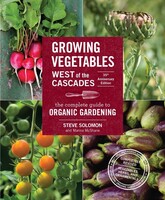Book notes: Growing Vegetables West of the Cascades
Oct 02, 2024
By Steve Solomon.
This is the 35th Anniversary Edition of the book.
Our little garden hasn’t produced much fruit or vegetables over the past 3 years and I set out to figure out what to do about it.
Most gardening techniques and advice are for midwest farming (East of the Cascades).
The stories of hard-won wisdom were very interesting. The author had dental problems he suspsects because of a typical lack of calcium in Northwest soil. He bought some acerage in Oregon when he saw that the well had enough water, not knowing that the water table drops in the summer, in his case from 15 gallons per minute down to 3, which then encouraged him to learn about “dry gardening”. There are some fun rants as well, one about whatever “magical” gardening trick that you do to get things to work, because why not?
Soil: use Complete Organic Fertilizer (COF) …
- 3 quartes oilseed meal
- 1 quart fish meal
- 1 pint blood meal
- 1 pint agricultural lime
- 1 pint agricultural gypsum
- 1 quart either rock phosphate or bone meal or guano
- 2 tsp borax
- 1.5 tsp zinc sulphite
- 1 tsp copper sulphate
- 1 pint kelp meal
… and because this is so fussy I’ll be buying fertilizer from the store, with an eye on some kind of mix that is appropriate for the area. Apply fertilizer in different amounts depending on low/medium/high requirement of the plant. Don’t side-dress after August. Nitrogen-fixing plants like squash don’t give enough nitrogen back to the ground, you have to use fertilizer. Don’t let weeds grow in your garden.
Composting: Recommends 7’ x 7’ area, with a compost heap about 5-6’ tall. Make your own, don’t trust foreign compost because it could bring disease/pests/weeds. You don’t need compost, you can can get by with just fertilizer. Again, I plan to completely disregard this advice and buy compost.
Planning:
- Have a plan on paper!
- I plan on herbs, carrots, scallions, garlic, onions, chard, kale, potatoes, squash, tomatoes.
- Plants shouldn’t touch (plant many seeds but thin them out). Give them a lot of space, will get bigger & more abundant produce from each plant over a more intensive spacing.
- Fertilize at first planting and every month.
- Don’t plant the same family group in the same spot:
- Solanums: tomatoes
- Legumes: beans, peas
- Greens: celery, lettuce, mustard, spinach, chard, arugula, spices
- Brassicas: broccoli, cabbage, cauliflower, collards, kale
- Roots: carrots, potatoes
- Cucurbits: cucumbers, melons, squash
- Rotation: separate garden into 2 sections:
- Spring garden started on half that grew a cover crop over winter.
- Summer garden: on beds that previously had autumn and winter vegetables, then do a cover crop over winter.
- Winter vegetables grow in the last few warm days of the fall season, and then they stop growing in winter but are availble for a long harvest period, like cold storage.
Planting dates for the Puget Sound area (every ~4 weeks or so):
- March 15: peas, spinach (St pats day: at least 1 potato, nice!).
- April 10: nearly everything except solanums & cucurbits.
- May 5: tranplant tomatoes
- June 1: cucumbers, summer squash
- June 25: still time for more lettuce & scallions
- July 20: kale, spinach
- August 15: endive, spinach, overwintering onions
- September: garlic
- October: cover crops
Tomatoes: Give them a lot of space. Mid-july, remove 2/3 flower clusters. Sept, remove all flower clusters. Consistent watering to prevent splitting. Green tomatoes can ripen indoors at ~50F until coloring, then ~70 to finish them off.
There is a fantastic amount of advice in the book, most of it in word form. Some of it would be better served by pictures and videos. (The author says as much in the book.) It was compelling for me though, I look forward to trying out many of the ideas, and will keep a copy on hand for reference.